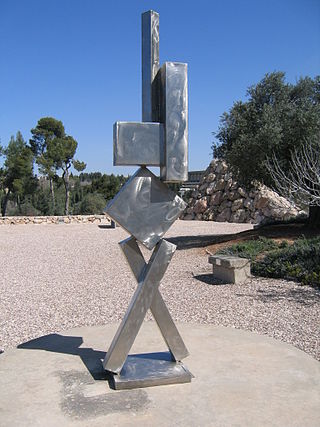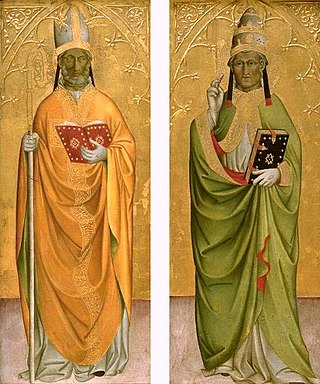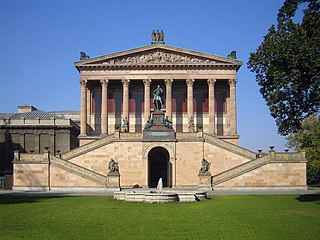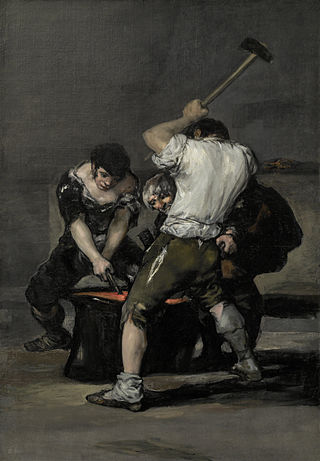
A mural is any piece of graphic artwork that is painted or applied directly to a wall, ceiling or other permanent substrate. Mural techniques include fresco, mosaic, graffiti and marouflage.

Edgar Degas was a French Impressionist artist famous for his pastel drawings and oil paintings.

Abstract expressionism in the United States emerged as a distinct art movement in the immediate aftermath of World War II and gained mainstream acceptance in the 1950s, a shift from the American social realism of the 1930s influenced by the Great Depression and Mexican muralists. The term was first applied to American art in 1946 by the art critic Robert Coates. Key figures in the New York School, which was the epicenter of this movement, included such artists as Arshile Gorky, Jackson Pollock, Franz Kline, Mark Rothko, Norman Lewis, Willem de Kooning, Adolph Gottlieb, Clyfford Still, Robert Motherwell and Theodoros Stamos among others.

Color field painting is a style of abstract painting that emerged in New York City during the 1940s and 1950s. It was inspired by European modernism and closely related to abstract expressionism, while many of its notable early proponents were among the pioneering abstract expressionists. Color field is characterized primarily by large fields of flat, solid color spread across or stained into the canvas creating areas of unbroken surface and a flat picture plane. The movement places less emphasis on gesture, brushstrokes and action in favor of an overall consistency of form and process. In color field painting "color is freed from objective context and becomes the subject in itself."

Cennino d'Andrea Cennini was an Italian painter influenced by Giotto. He was a student of Agnolo Gaddi in Florence. Gaddi trained under his father, called Taddeo Gaddi, who trained with Giotto.

Adolph Friedrich Erdmann von Menzel was a German Realist artist noted for drawings, etchings, and paintings. Along with Caspar David Friedrich, he is considered one of the two most prominent German painters of the 19th century, and was the most successful artist of his era in Germany. First known as Adolph Menzel, he was knighted in 1898 and changed his name to Adolph von Menzel.
Michael Martin Fried is a modernist art critic and art historian. He studied at Princeton University and Harvard University and was a Rhodes Scholar at Merton College, Oxford. He is the J.R. Herbert Boone Professor Emeritus of Humanities and Art History at the Johns Hopkins University, Baltimore, Maryland, United States.
Wolf Kahn was a German-born American painter.

The Alte Nationalgalerie is a listed building on the Museum Island in the historic centre of Berlin, Germany. The gallery was built from 1862 to 1876 by the order of King Frederick William IV of Prussia according to plans by Friedrich August Stüler and Johann Heinrich Strack in Neoclassical and Renaissance Revival styles. The building's outside stair features a memorial to Frederick William IV. Currently, the Alte Nationalgalerie is home to paintings and sculptures of the 19th century and hosts a variety of tourist buses daily. As part of the Museum Island complex, the gallery was inscribed on the UNESCO World Heritage List in 1999 for its outstanding architecture and its testimony to the development of museums and galleries as a cultural phenomenon in the late 19th century.
Suzan Frecon is a contemporary artist who lives and works in New York. She is represented by Lawrence Markey, San Antonio and David Zwirner, New York.

The Forge is a c. 1817 painting by Francisco Goya (1746–1828), today housed in the Frick Collection in New York City. The large oil on canvas represents three blacksmiths toiling over an anvil, and has been described by the art historian Fred Licht as "undoubtedly the most complete statement of Goya's late style."

Alexander Adriaenssen was a Flemish Baroque painter, particularly known for his still-lifes of fish and game pieces. He also painted banquet pieces with food and flower still lifes.

The Old Musician is an 1862 oil painting on canvas by French painter Édouard Manet, produced during the period when the artist was influenced by Spanish art. The painting also betrays the influence of Gustave Courbet. This work is one of Manet's largest paintings and is now conserved at the National Gallery of Art in Washington, DC.

Arrangement in Grey and Black, No. 2: Portrait of Thomas Carlyle is an 1872–73 oil painting by James McNeill Whistler. It depicts the Scottish essayist, historian and philosopher Thomas Carlyle in a composition similar to that of Whistler's 1871 Arrangement in Grey and Black No. 1: Portrait of the Artist's Mother, commonly known as Whistler's Mother. It is now in the Kelvingrove Art Gallery and Museum in Glasgow, Scotland.

Yvonne Thomas was an American abstract artist.
Harry Fidler (1856–1935) was a British painter known for including farm animals and especially horses in his impressionistic paintings, typically using heavy impasto. He married Laura Clunas, who was an artist with a similar style.

Psyche Abandoned is a c. 1795 painting by Jacques-Louis David, now in a private collection. It shows Psyche as a crouching female nude in profile against a blue sky with a hill in the background. She stares at the viewer with an expression of loss, pain, and betrayal. Thought to have been painted during David's imprisonment during the French Revolution, it dates from either 1794 or 1795. Vertical in format, it diverges from the academic conventions for representing the female nude.

Judith and Her Maidservant is one of four paintings by the Italian baroque artist Artemisia Gentileschi that depicts the biblical story of Judith and Holofernes. This particular work, executed in about 1623 to 1625, now hangs in the Detroit Institute of Arts. The narrative is taken from the deuterocanonical Book of Judith, in which Judith seduces and then murders the general Holofernes. This precise moment illustrates the maidservant Abra wrapping the severed head in a bag, moments after the murder, while Judith keeps watch. The other three paintings are now shown in the Museo di Capodimonte in Naples, the Palazzo Pitti in Florence, and the Musée de la Castre in Cannes.

The Balcony Room is an oil-on-canvas painting by the German artist Adolph Menzel, executed in 1845. It is one of the main works of his early period and one of his most famous paintings. It has belonged to the collection of the Alte Nationalgalerie in Berlin, since 1903.

The Iron Rolling Mill (Modern Cyclopes) is an oil on canvas painting by German artist Adolph Menzel, created in 1872-1875. The painting is one of his main works from the time when the painter was mostly concerned with contemporary issues and the social question as a result of the uninhibited technical advances made during the Industrial Revolution, particularly in Germany. It has the large dimensions of 158 by 254 cm. The signature of the artist can be seen at the lower left: "Signatur Adolph Menzel. Berlin 1875". The realistic painting caused a stir at the time and is now part of the collection of the Alte Nationalgalerie, in Berlin.

















